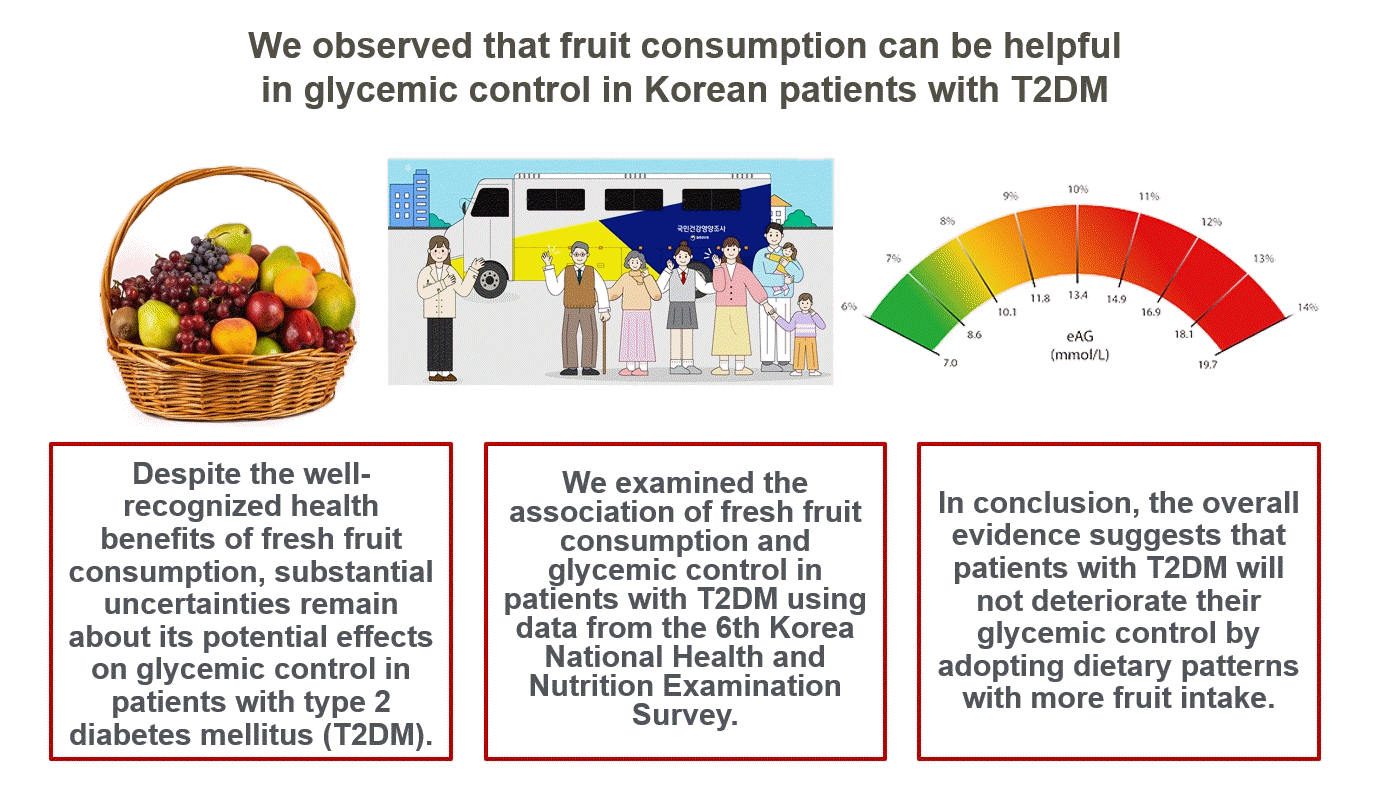Abstract
Background
Methods
Results
ACKNOWLEDGMENTS
REFERENCES
Table 1.
| Characteristic | Tertile 1 | Tertile 2 | Tertile 3 | P value |
|---|---|---|---|---|
| Number (sample count) | 153 | 154 | 153 | |
| Weekly fruit consumption frequency | 1.33±0.09 | 5.21±0.13 | 13.18±0.45 | <0.001 |
| Fruit consumption per day above the recommendation, %a | 0.0 | 12.1 | 79.3 | <0.001 |
| Age, yr | 51.84±0.93 | 51.45±0.82 | 54.39±0.78 | 0.021 |
| Women, % | 26.9 | 33.6 | 52.2 | <0.001 |
| BMI, kg/m2 | 25.61±0.47 | 25.24±0.34 | 24.87±0.24 | 0.300 |
| Mean HbA1c, % | 7.91±0.19 | 7.80±0.15 | 7.32±0.14 | 0.018 |
| HbA1c <7%, % | 42.0 | 35.9 | 51.3 | 0.080 |
| Fasting plasma glucose, mg/dL | 152.62±5.14 | 153.35±6.00 | 144.50±4.68 | 0.384 |
| Duration of diabetes, yr | 8.08±0.68 | 6.41±0.69 | 7.65±0.55 | 0.204 |
| Treated with insulin, % | 17.1 | 12.4 | 5.5 | 0.055 |
| Treated with OHA, % | 76.5 | 85.8 | 84.8 | 0.166 |
| SBP, mm Hg | 125.00±1.59 | 121.80±1.55 | 120.39±1.35 | 0.080 |
| DBP, mm Hg | 78.07±1.05 | 78.49±1.02 | 75.68±0.94 | 0.081 |
| LDL cholesterol, mg/dL | 102.96±4.42 | 103.12±3.86 | 101.14±4.11 | 0.930 |
| HDL cholesterol, mg/dL | 43.83±1.17 | 46.17±1.07 | 46.71±1.12 | 0.179 |
| Triglycerides, mg/dL | 234.12±28.60 | 215.25±26.89 | 162.16±9.25 | 0.016 |
| Current smoker, % | 36.9 | 33.2 | 16.0 | 0.009 |
| Alcohol intake frequency per week, %b | 0.030 | |||
| Never | 28.5 | 25.5 | 34.3 | |
| ≤Once | 34.8 | 45.1 | 48.3 | |
| >Once | 36.7 | 29.4 | 17.4 | |
| KHEI total score (0–100)c | 60.24±1.15 | 65.37±1.05 | 70.02±0.98 | <0.001 |
| Walking for ≥10 minutes, % | 0.022 | |||
| 7 days/week | 27.0 | 34.1 | 30.2 | |
| 5–6 days/week | 10.1 | 13.0 | 25.7 | |
| 3–4 days/week | 22.8 | 19.6 | 15.3 | |
| 1–2 days/week | 21.2 | 10.4 | 16.4 | |
| 0 day/week | 18.8 | 23.0 | 12.3 |
Values are expressed as mean±standard deviation. All values except numbers are sample weighted. The study sample was divided into three groups based on weekly fruit consumption frequency: less than 2.82 times (tertile 1), 2.82–7.63 times (tertile 2), and more than 7.63 times (tertile 3).
BMI, body mass index; HbA1c, hemoglobin A1c; OHA, oral hypoglycemic agent; SBP, systolic blood pressure; DBP, diastolic blood pressure; LDL-C, low-density lipoprotein cholesterol; HDL-C, high-density lipoprotein cholesterol; KHEI, Korean Healthy Eating Index.
a Energy intake from fruits exceeds 100 kcal, which is equivalent to 2 exchange units of fruits [12];
c KHEI score range [13].
Table 2.
| Variable | Tertile 1 | Tertile 2 | Tertile 3 | P value |
|---|---|---|---|---|
| Total energy, kcal | 1,781.74±71.251 (0.82±0.03)a | 1,962.32±71.31 (0.92±0.03)a | 2,111.62±68.91 (1.04±0.03)a | 0.007 (<0.001) |
| Carbohydrate, g | 287.03±10.31 (0.66±0.01)b | 310.88±9.56 (0.65±0.01)b | 349.58±10.10 (0.68±0.01)b | <0.001 (0.032) |
| Protein, g | 51.77±2.69 (0.11±0.002)b | 62.45±2.83 (0.13±0.002)b | 68.10±2.71 (0.13±0.002)b | <0.001 (<0.001) |
| Fat, g | 27.15±2.10 (0.06±0.003)b | 34.47±2.00 (0.07±0.002)b | 37.79±2.05 (0.07±0.002)b | 0.002 (0.001) |
| Dietary fiber, g | 15.30±0.63 (0.65±0.03)c | 20.69±0.82 (0.89±0.03)c | 27.19±0.92 (1.22±0.04)c | <0.001 (<0.001) |
| Vitamin A, μgRE | 412.62±26.83 (0.60±0.04)c | 628.47±32.63 (0.92±0.04)c | 763.01±36.65 (1.16±0.06)c | <0.001 (<0.001) |
| Vitamin B1, mg | 1.48±0.06 (1.26±0.05)c | 1.78±0.07 (1.52±0.06)c | 2.04±0.07 (1.77±0.06)c | <0.001 (<0.001) |
| Vitamin B2, mg | 0.93±0.06 (0.66±0.04)c | 1.21±0.06 (0.86±0.04)c | 1.35±0.06 (1.01±0.04)c | <0.001 (<0.001) |
| Niacin, mg | 10.20±0.52 (0.66±0.03)c | 12.76±0.53 (0.83±0.03)c | 15.09±0.58 (1.01±0.04)c | <0.001 (<0.001) |
| Vitamin C, mg | 41.46±2.21 (0.41±0.02)c | 91.63±3.28 (0.92±0.03)c | 170.69±5.64 (1.71±0.06)c | <0.001 (<0.001) |
| Calcium, mg | 346.95±18.35 (0.49±0.03)c | 468.68±23.20 (0.66±0.03)c | 539.55±23.50 (0.77±0.03)c | <0.001 (<0.001) |
| Phosphorous, mg | 794.98±34.74 (1.14±0.05)c | 982.01±42.62 (1.40±0.06)c | 1,108.26±39.41 (1.58±0.06)c | <0.001 (<0.001) |
| Iron, mg | 11.21±0.52 (1.20±0.06)c | 14.13±0.59 (1.50±0.07)c | 16.32±0.59 (1.83±0.07)c | <0.001 (<0.001) |
| Potassium, mg | 1,918.95±81.12 (0.55±0.02)c | 2,669.39±108.43 (0.76±0.03)c | 3,468.85±116.16 (0.99±0.03)c | <0.001 (<0.001) |
| Sodium, mg | 2,550.31±152.57 (1.28±0.08)c | 3,272.59±160.75 (1.64±0.08)c | 3,574.83±168.46 (1.79±0.08)c | <0.001 (<0.001) |
a Energy intake ratio compared to Estimated Energy Requirements recommended by the Dietary Reference Intake for Koreans (KDRIs) [32];
Table 3.
Model 1 is adjusted by sex and age; Model 2 is adjusted by sex, age, body mass index, systolic blood pressure, triglycerides, low-density lipoprotein cholesterol, current smoking, and alcohol intake; Model 3 is adjusted by Model 2 plus total energy intake; Model 4 is adjusted by Model 3 plus walking per week and dietary fiber intake; Model 5 is adjusted by Model 4 plus insulin treatment.




 PDF
PDF Citation
Citation Print
Print




 XML Download
XML Download